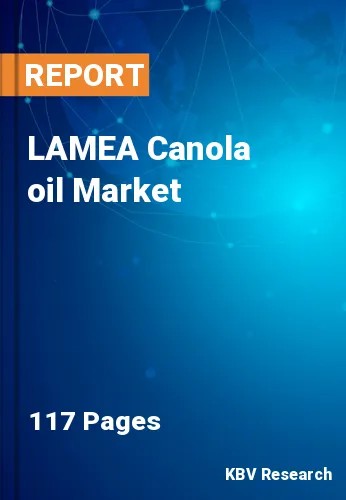The Latin America, Middle East and Africa Canola Oil Market would witness market growth of 4.6% CAGR during the forecast period (2023-2030). In the year 2026, the LAMEA market's volume is expected to surge to 2,648.1 Kilo Tonnes, showcasing a growth of 6.2% (2023-2030).
The growing emphasis on sustainable and environmentally friendly agriculture has buoyed Canola oil's adoption. Canola plants have a comparatively small environmental footprint and require fewer pesticides than other oilseed crops, making them a sustainable option for farmers and a selling point for eco-conscious consumers. Marketing and promotional efforts by the market and health organizations have successfully communicated the benefits of canola oil. This has further driven its adoption among consumers seeking healthier cooking and eating alternatives.
It is predominantly used in cooking. Its high smoke point of approximately 400 degrees Fahrenheit (204 degrees Celsius) makes it suitable for deep-frying, sautéing, and stir-frying. The food industry frequently uses canola oil to produce snacks, processed foods, and ready-to-eat meals. Its neutral taste allows food manufacturers to create products with a consistent flavor profile, and its stability ensures extended shelf life for many processed foods. It is a key feedstock in the production of biodiesel.
Rapid urbanization in many LAMEA countries has led to consumer lifestyle and preferences changes. Urban dwellers often seek convenient and ready-to-eat food options, driving the demand for processed foods and encouraging the growth of the food processing sector. The LAMEA region is known for its diverse culinary traditions. The food processing sector is leveraging this diversity to develop a wide range of ethnic and regional products, catering to local and international markets. Based on the data released by the United States Department of Agriculture, according to the Brazilian Food Processors' Association (ABIA), the country's food processing sector registered revenues of R$922.6 billion (US$171 billion) in 2021, an increase of 16.9 percent compared to 2020. Therefore, the growth of the foodservice sector in UAE and the food processing sector in Brazil are the factors that can help in the expansion of the market in the LAMEA region.
The Brazil region dominated the LAMEA Canola oil Market by Country in 2022 and would continue to be a dominant market till 2030; thereby, achieving a market value of $780.5 Million by 2030. The Argentina region is showcasing a CAGR of 5.2% during (2023 - 2030). Additionally, The UAE region would register a CAGR of 4.2% during (2023 - 2030).
Based on Nature, the market is segmented into Conventional, and Organic. Based on Application, the market is segmented into Food Processing, Food Service, Households, and Others. Based on countries, the market is segmented into Brazil, Argentina, UAE, Saudi Arabia, South Africa, Nigeria, and Rest of LAMEA.
Free Valuable Insights: The Worldwide Canola oil Market is Projected to reach USD 43.3 Billion by 2030, at a CAGR of 3.9%
The market research report covers the analysis of key stake holders of the market. Key companies profiled in the report include Louis Dreyfus Company B.V., Cargill, Incorporated, Associated British Foods PLC, Archer Daniels Midland Company, Wilmar International Limited, Bunge Limited, Jivo Wellness Pvt. Ltd., American Vegetable Oils, Inc., Richardson International Limited and La Tourangelle, Inc.
By Nature Volume, Kilo Tonnes, USD Million, 2019-2030)
By Application (Volume, Kilo Tonnes, USD Million, 2019-2030)
By Country (Volume, Kilo Tonnes, USD Million, 2019-2030)
Our team of dedicated experts can provide you with attractive expansion opportunities for your business.

